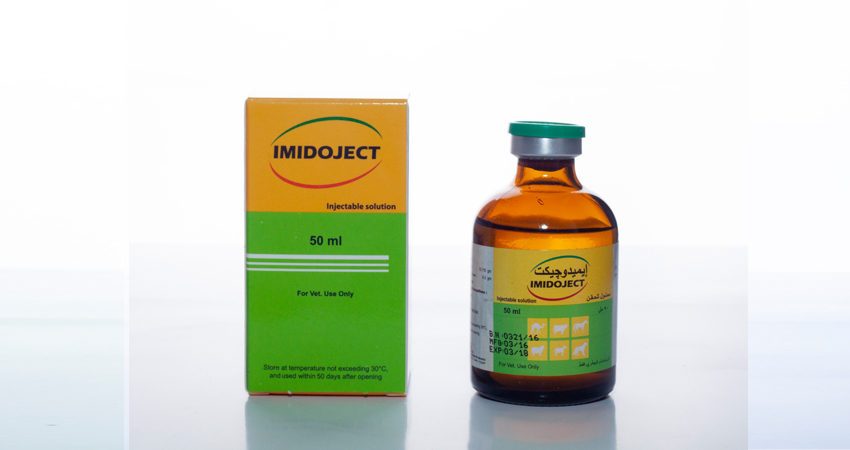Composition
Each 100 ml contains:
Imidocarb dipropionate 12.115 gm
Equivalent to Imidocarb base 8.500 gm
Properties
Imidocarb dipropionate is a substituted carbanilide, used as an antiprotozoan treatment for the control of Babesia spp.Little is known about the mode-of-action of imidocarb dipropionate. It appears that imidocarb acts directly on the parasite, causing alteration in number and size of nuclei and in morphology (vacuolation) of the cytoplasm. The antiprotozoan activity is derived from the carbanilide acting on glycolyis of the parasite. This is the result of this class of drugs giving rise to hypoglycaemia in the host. Babesia as well as many other parasites like trypanosomes depend upon host glucose for aerobic glycolysis.There is also a selective blocking effect on the replication of the quinetoplastic DNA of the parasite.
Indications
Cattle:
For the treatment of Redwater fever (babesiosis) caused by B. bigemina and B. bovis.
Dogs:
For the treatment of Redwater fever (babesiosis) caused by B. canis, B. vogeli and B. rossi.
Target species
Cattle and Dogs
Dosage & Administration
Route of administration: The product is for subcutaneous injection administration only
For whole product:
Cattle:
- 1.0 ml Imidoject / 100 kg body weight as a single dose
Dogs:
- 0.25 ml Imidoject / 10 kg body weight as a single dose.
Warnings
- – Imidocarb is a potent cholinesterase inhibitor. The dosage varies according to the species and the desired purpose. In all cases, it must be strictly adapted to the weight of the animal.
Precautions
Precautions for humans:
- Do not use if under medical advice not to work with compounds which may exhibit anti-cholinesterase activity.
- Wash splashes of the product off the skin and eyes immediately. Wear suitable protective clothing (ie impermeable gloves) when using the product.
- Seek medical advice immediately if adverse signs indicative of anti-cholinesterase activity are experienced by operators
Precautions for animals:
- Estimate bodyweight carefully and do not exceed the recommended dosage.
- Do not administer intravenously.
- Strictly observe the indicated doses and avoid the combination with other babesicides.
- Administration of higher dosages can be painful and cause defense reactions in animals. Some dogs are particularly sensitive to this pain.
Precautions during pregnancy, lactation and laying:
- Treatment of pregnant animals has demonstrated that although the compound does cross the placental barrier there does not appear to be an adverse effect on the foetus or calf.
Contra Indications
- The product must not be administered intravenously or intramuscularly.
- Repeat doses of the product must not be given.
Drug-drug interaction:
- None known
Side Effects
- Animals may show cholinergic signs after dosing. It may be possible to alleviate these side effects by treatment with atropine sulphate.
- While side-effects (salivation, discomfort, muscle tremors, tachycardia, cough, colics) are rare, they do occur and deaths from anaphylactoid reactions have been recorded following product use.
Poisoning:
- At about 1.75x overdose of the recommended dose signs consistent with cholinergic activity started to manifest themselves.
- Death can result at doses of 5x the recommended therapeutic dose or greater.
Withdrawal time:
- Animals must not be slaughtered for human consumption during treatment. Cattle may be slaughtered for human consumption only after a period of at least 213 days from treatment.
- Milk for human consumption must not be taken during treatment. Milk must not be taken for human consumption from cattle until after at least 21 days from treatment.
Storage condition
In the original pack, at temperature not exceeding 30°C and valid for 50 days after opening
Packaging
Carton box containing amber glass (type П) vials of 10, 40, 50, 100, 250 & 500 ml solution with red chlorobutyl rubber stopper, with an outer label & insert leaflet

